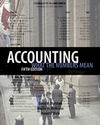 |  Accounting: What the Numbers Mean, 5/e David H. Marshall,
Millikin University
Wayne W. McManus,
International College of the Cayman Islands
Daniel F. Viele,
Webster University
The Bookkeeping Process and Transaction Analysis
Chapter 4 Outline
The Bookkeeping/Accounting |
 |  |  | - Owners' Equity expanded:
- OE = Paid-in Capital + Retained Earnings
- Net income causes retained earnings to increase
- Net income = Revenues - Expenses
- OE = Paid-in Capital + Retained Earnings (beginning)
+ Revenues - Expenses
- The Balance Sheet Equation expanded:
A = L + PIC + Retained Earnings (beginning) +
Revenues - Expenses - Equation stays in balance after every transaction
- Illustration of the effect of transactions on the equation
|
 |  |  | Bookkeeping Jargon and Procedures- Transactions recorded in a journal, then posted to an account in
the ledger.
- Accounts use a "T" format
- Left side of "T" is debit
- Right side of "T" is credit
- Normal balances
- Debit: Assets and expenses
- Credit: Liabilities, owners' equity, and revenues
- Journal entry
- Transaction entries
- Adjusting entries
|
 |  |  | Effect of Transactions on the Financial Statements (Horizontal Model) |
 |  |  | Transaction Analysis Methodology- Five questions:
- What's going on?
- What accounts are affected?
- How are they affected?
- Does the balance sheet balance?
- Does my analysis make sense?
- Illustration of applying the five questions
- Understanding the reasons for changes in account balances
|
 |  |  | Adjustments/Adjusting Entries- Accruals
- Reclassifications
|
|


 2002 McGraw-Hill Higher Education
2002 McGraw-Hill Higher Education